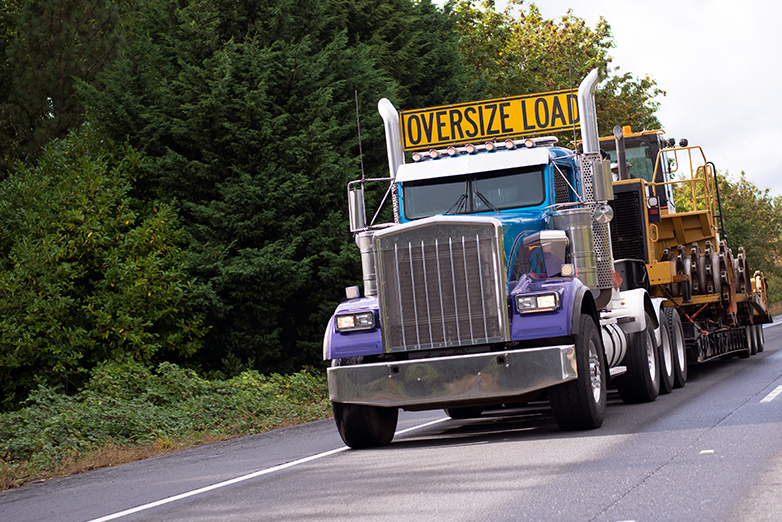
Transporting oversized and overweight loads requires heavy haul permits, monitoring and following load per axle limits, and sometimes even escort or pilot cars to help the driver navigate traffic. Some loads require even more special attention — like tall loads, for example — because they need skid poles to push up wires and traffic lights so that the truck can safely fit under them.
Heavy haul vehicles are difficult to drive under the very best circumstances and even more difficult in close quarters, on busy job sites or in less-than-ideal road conditions. Sometimes, crashes happen.
According to the Bureau of Labor Statistics, highway crashes and work zone accidents are the second-largest cause of on-the-job deaths in the construction industry. When a driver of a heavy haul vehicle is involved in an on-the-job crash or incident, the result can be serious injury or even death.
These heavy haul vehicles can also be hazardous to roadway structures like highways, residential roadways and bridges, while also causing dangerous traffic conditions for other drivers on the road. It is up to the driver of the heavy haul vehicle to manage risks when driving and keep everyone safe on the road.
Here are five ways drivers can manage risks when driving oversized and overweight vehicles with heavy loads:
#1: Know your route.
Legal dimensions and weights vary from state to state, and heavy haul permits dictate the route a truck can take, including specific dates and times it is allowed to be on the road. GPS tracking and fleet telematics can help managers track where their trucks are at any given time and if they are following routes allowed by the permits.
#2: Practice safe driving habits.
Safe driving habits are absolutely essential when driving a heavy haul vehicle — especially in residential areas. Drivers are often maneuvering in close quarters and have to not only protect themselves and other drivers on the job site but also protect other drivers on the road and in the community.
#3: Don’t drive drowsy or distracted.
Drowsy and distracted driving are leading causes of crashes on U.S. roadways. The dangers for drivers of oversized hauls increase exponentially due to of the size and weight of the vehicle and the unique challenges faced on the road. Formal distracted and drowsy driving policies should be created, monitored and enforced to ensure that all drivers are focusing their full attention on the road at all times.
#4: Be careful backing up.
As much as 60% of accidents occur when a vehicle is in reverse. These types of crashes can be avoided when drivers have the skills, knowledge and experience they need to maneuver fleet trucks in close quarters and to feel comfortable in traffic and in tight spaces.
#5: Don’t risk being out of compliance.
Regulations around heavy haul drivers, companies and vehicles can be tedious and confusing, but compliance is necessary to remain in good standing with the Department of Transportation. Safety and compliance training can help to ensure your fleet is up-to-date on all of the safety regulations to keep your safety rating high.
The True Cost of On-the-Job Crashes and At-Fault Incidents
When heavy haul drivers are involved in on-the-job crashes and incidents, people get hurt and property gets damaged. The cost can also be significant to the parent company’s bottom line, as many companies are self-insured.
In 2013, motor vehicle crashes cost U.S. employers $47.4 billion and were responsible for 1,600 deaths, according to the most recent data by the Network of Employers for Traffic Safety (NETS). Some $25.17 billion of this was related to on-the-job crashes. In each fatality, the cost per incident to the parent company was more than $671,000 and $65,00 for each nonfatal injury.
Total direct costs per year also include property damage associated with a crash, as well as related medical and legal expenses, health care costs, potential liability claims and lost productivity.
How Advanced Driver Training Can Help
Driver behavior has a direct effect on the number of on-the-job crashes and a company’s bottom line. The good news is that driver behavior can be improved through advanced driver training and therefore, most on-the-job crashes and at-fault incidents can be prevented.
Advanced driving schools and training programs enable instructors to see and correct drivers’ actual driving habits in real time. Classroom training, combined with behind-the-wheel instruction, can change driving habits, help drivers manage risk and ultimately reduce crashes.
Drivers of heavy haul vehicles face all of the challenges of the road in addition to the unique challenge of transporting oversized and overweight loads. By hiring the right drivers, teaching them to drive more defensively and obtaining the right permits, drivers are able to manage risks and improve the safety of everyone on the road.
To learn more about how advanced driver training based on The Smith5Keys® can help your fleet transport heavy loads more safely and efficiently, contact the Smith System team of experts.









